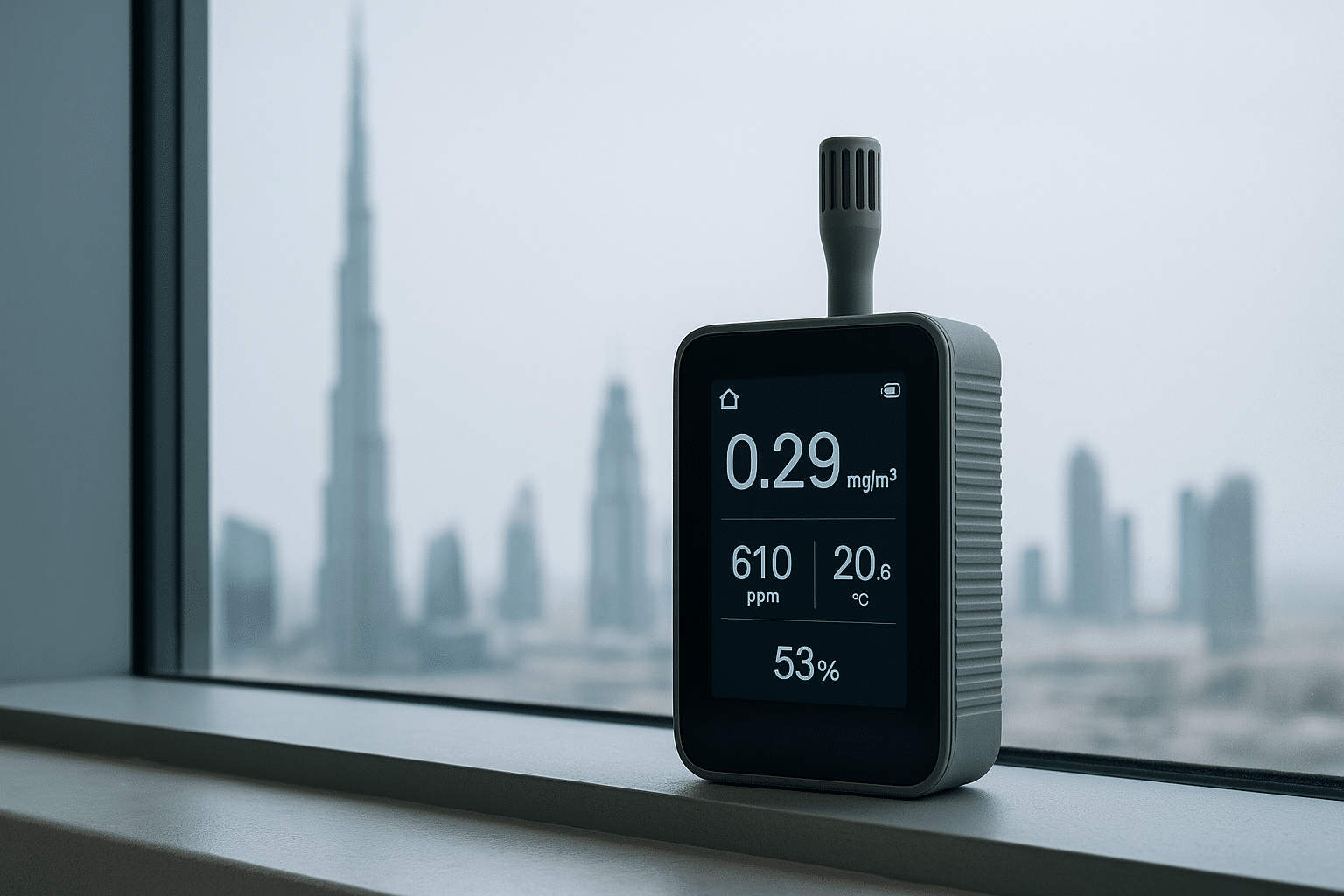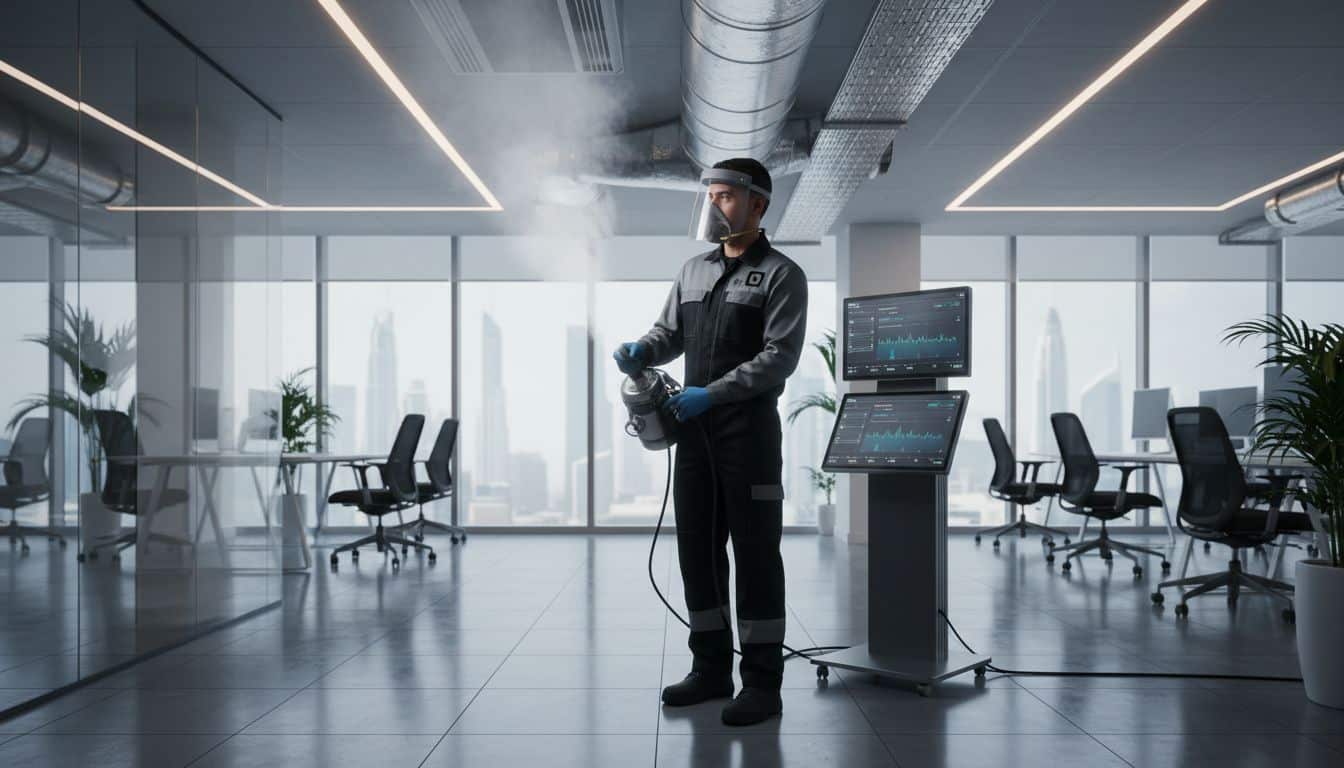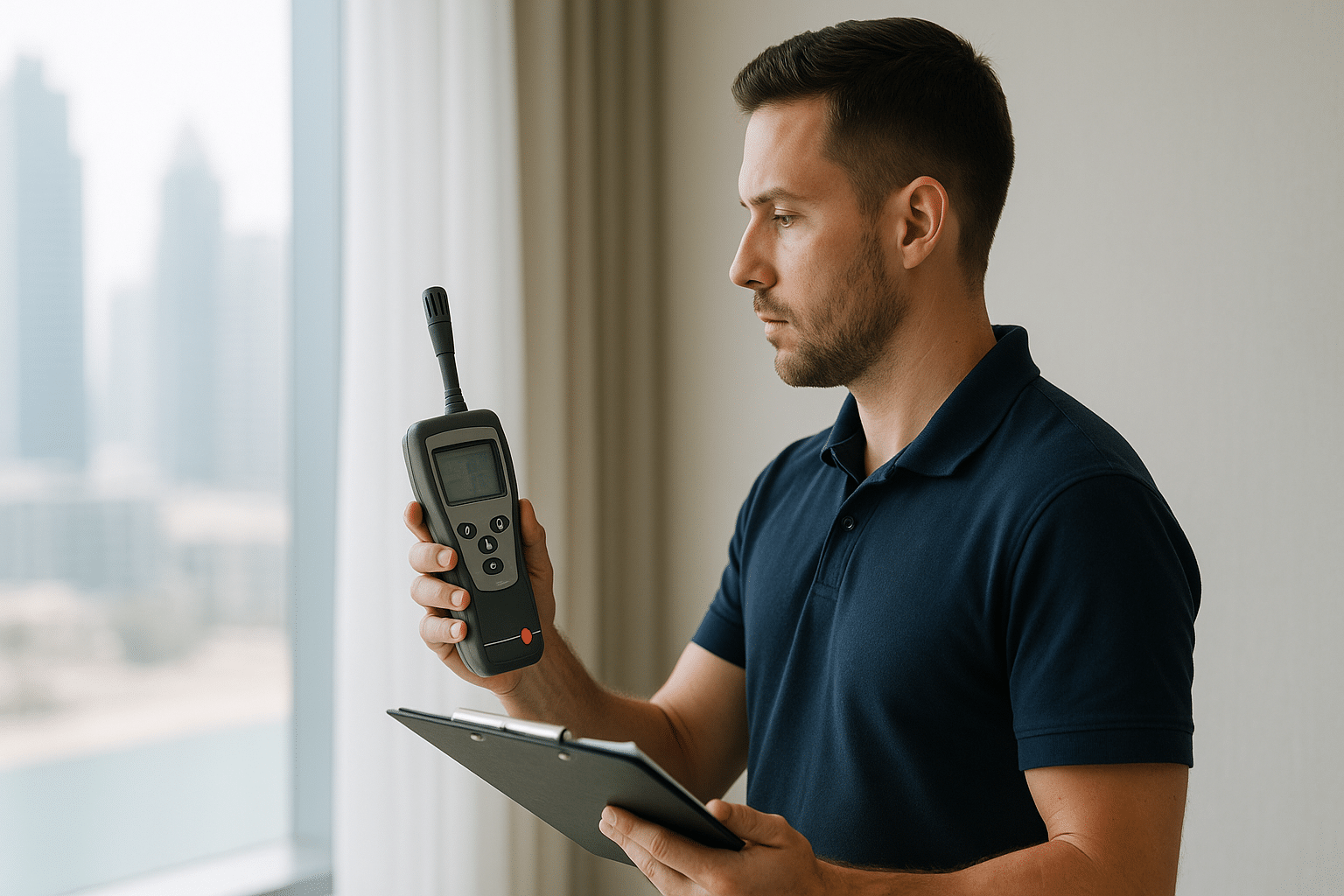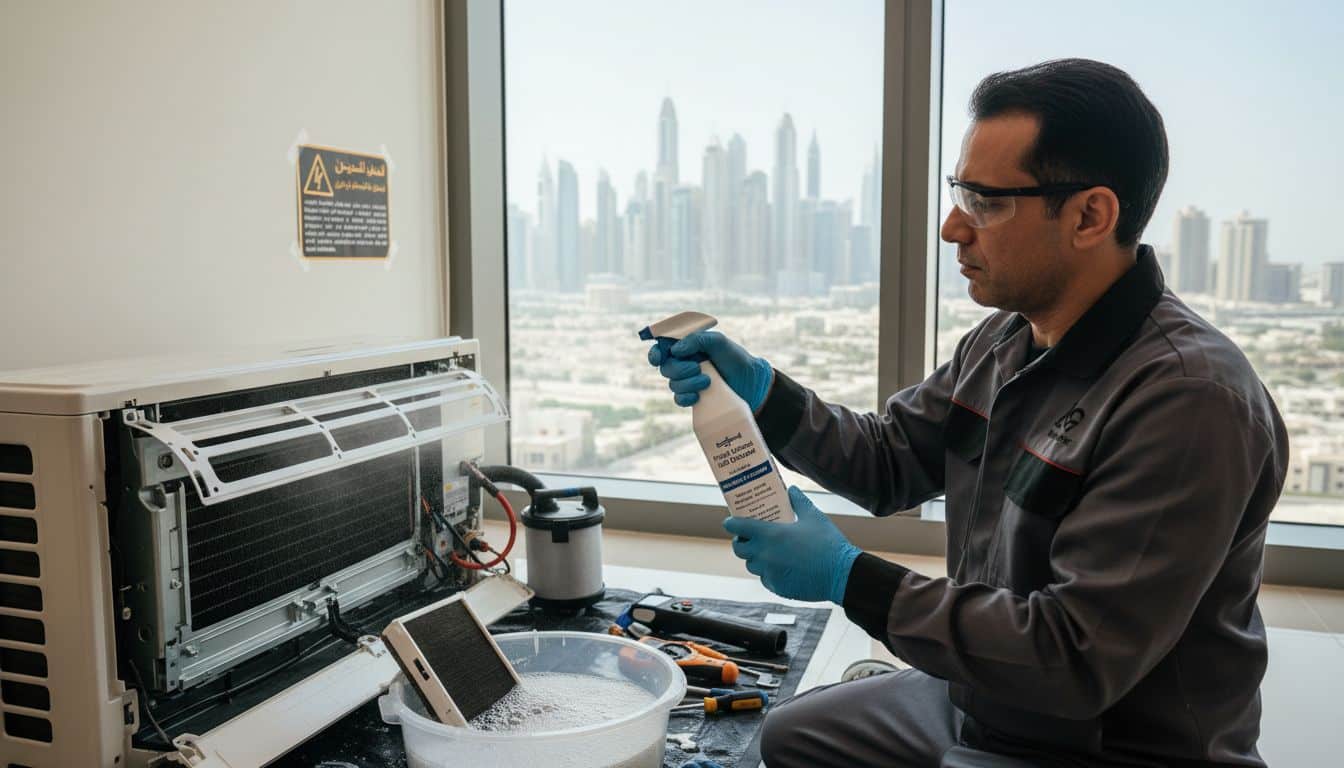
10 Revealing Technical Guidelines for Indoor Air Quality Dubai: Service Considerations for Duct Cleaning Services
Table of Contents
Contents
- 1 Table of Contents
- 2 Introduction
- 3 Importance of Indoor Air Quality in Dubai
- 4 Regulatory Framework Governing Indoor Air Quality Dubai
- 5 Overview of Duct Cleaning Services
- 6 Technical Guidelines for Duct Cleaning
- 7 Detailed Service Considerations for Duct Cleaning Services
- 8 Benefits of Compliance with Technical Guidelines
- 9 Common Challenges and Solutions
- 10 Choosing the Right Service Provider in Dubai
- 11 Conclusion & Call to Action
- 12 Enhancing Compliance with Technical Guidelines for Indoor Air Quality Dubai
- 12.1 Understanding the Regulatory Framework and Key Standards
- 12.2 Application of Advanced Technological Solutions in IAQ Management
- 12.3 Integrating IAQ Guidelines into Building Management and Maintenance Protocols
- 12.4 The Role of Dubai-Specific Environmental Challenges in IAQ Management
- 12.5 Collaborative Enforcement and Continuous Improvement
Introduction
The topic of technical guidelines for indoor air quality Dubai is crucial for maintaining comfortable and healthy environments, especially in a city with unique climatic and urban challenges. This article unveils thorough service considerations for duct cleaning services, which directly impact indoor air quality, according to Dubai’s regulations and recommended practices.
Importance of Indoor Air Quality in Dubai
Indoor air quality (IAQ) significantly influences residents’ health and productivity in Dubai’s diverse living and working spaces such as Downtown Dubai, Business Bay, and Dubai Marina. Dubai’s desert climate, combined with rapid urbanization, means dust accumulation and pollution indoors is a persistent issue. Ensuring excellent indoor air quality not only helps reduce respiratory ailments but also supports overall well-being and compliance with Dubai Municipality standards.
Regulatory Framework Governing Indoor Air Quality Dubai
Dubai’s approach to indoor air quality is governed mainly by the Dubai Municipality, which issues technical guidelines for indoor air quality Dubai that target air filtration, duct maintenance, and HVAC system performance. These guidelines integrate with Dubai Health Authority and Dubai Health & Safety protocols to ensure safer indoor environments. Additionally, Dubai’s Energy and Water Authority (DEWA) encourages efficient HVAC operations that complement air quality requirements.
Overview of Duct Cleaning Services
Regular duct cleaning is a fundamental component of maintaining effective indoor air quality in Dubai. Duct systems, if neglected, accumulate dust, mold, and other contaminants. Cleaning these ducts contributes to removing allergens and pollutants, thus aligning with the technical guidelines for indoor air quality Dubai. Professional duct cleaning services typically cover inspection, debris removal, sanitization, and system performance checks.
Technical Guidelines for Duct Cleaning
Adhering to technical guidelines for indoor air quality Dubai during duct cleaning involves multiple critical steps:
- Inspection: Use of video cameras or specialized devices to assess duct conditions.
- Cleaning Methods: Employing suction, brushing, and HEPA-filtered vacuum systems that prevent the redistribution of contaminants in the air.
- Sanitization: Application of agents approved by Dubai Municipality to eliminate microbial buildup without compromising occupant safety.
- System Integrity: Ensuring ducts remain sealed and intact post-cleaning to prevent infiltration of new pollutants.
- Documentation and Certification: Providing proof of compliance with Dubai air quality standards and recommendations from certified bodies.
These technical guidelines for indoor air quality Dubai are designed to maximize the benefits of duct cleaning while minimizing health risks and operational disruptions.
Detailed Service Considerations for Duct Cleaning Services
In Dubai, the associated considerations for duct cleaning services vary depending on factors such as building size, duct system complexity, and service provider expertise. Rather than fixed prices, most companies offer assessments and customized quotations that consider the following elements:
| Service Element | Description | Impact on Service Scope |
|---|---|---|
| Initial Inspection | Use of diagnostic tools to evaluate duct condition and contamination levels. | Basis for defining service scope and complexity. |
| Cleaning Equipment and Techniques | Type and sophistication of equipment like HEPA vacuums or rotary brushes. | Affects thoroughness and duration of service. |
| Sanitization Products | Use of certified cleaning agents approved by Dubai authorities for microbial mitigation. | Necessary for compliance; influences chemical requirements. |
| Labor and Expertise | Certified technicians performing service within safety guidelines. | Higher skill levels may improve outcomes. |
| Post-Cleaning Testing | Verification through air quality tests or infrared checks. | Ensures compliance with local air quality guidelines. |
These components emphasize value and effectiveness, guiding Dubai residents and businesses in selecting reputable duct cleaning services.
Benefits of Compliance with Technical Guidelines
Following the technical guidelines for indoor air quality Dubai in duct cleaning yields several advantages:
- Health Improvement: Reduction of airborne allergens and pathogens protects occupants.
- Regulatory Adherence: Meets Dubai Municipality standards, avoiding penalties and enhancing building ratings.
- Energy Efficiency: Cleaner ducts improve HVAC function and reduce energy wastage, aligning with DEWA initiatives.
- Extended Equipment Life: Proper cleaning prevents wear and corrosion in ductwork and HVAC units.
- Enhanced Indoor Comfort: Balanced airflow and odor reduction contribute to better living and working conditions.
Common Challenges and Solutions
Despite the benefits, duct cleaning providers and property managers in Dubai encounter some challenges adhering to the technical guidelines for indoor air quality Dubai:
- Access Restrictions: Duct systems in commercial towers at Dubai Marina or Medos may be hard to access, requiring specialized tools.
- Indoor Environment Sensitivity: Minimizing disruption in occupied spaces is essential; scheduling and containment practices help.
- Verification of Service Quality: Employing technology such as high-resolution video and air quality monitors ensures service credibility.
- Environmental Considerations: Using eco-friendly sanitizers compliant with Dubai’s environmental guidelines.
Addressing these challenges demonstrates professionalism and ensures that technical guidelines for indoor air quality Dubai are effectively met.
Choosing the Right Service Provider in Dubai
When seeking duct cleaning services that meet the technical guidelines for indoor air quality Dubai, it is important to consider the following aspects:
- Certification and Accreditation: Choose companies certified by recognized UAE bodies and those participating in international programs like NADCA (technical guidelines for indoor air quality Dubai).
- Experience in Dubai Market: Providers familiar with Dubai’s regulations and climate can tailor services accordingly.
- Transparent Service Breakdown: Clear explanations of procedures and components help in trust-building.
- Customer Feedback and Reputation: Positive testimonials from Dubai-based clients indicate reliability.
For those in Dubai especially, companies like technical guidelines for indoor air quality Dubai specialize in duct cleaning and indoor air quality improvement fulfilling local technical guidelines.
Conclusion & Call to Action
Understanding and applying technical guidelines for indoor air quality Dubai, specifically regarding duct cleaning, is essential for creating safe, healthy indoor environments. While considerations vary, investing in professional duct cleaning aligned with local standards brings lasting health, operational, and energy benefits. Dubai residents and business managers should prioritize compliance and choose certified service providers who deliver transparent, effective cleaning solutions.
Enhancing Compliance with Technical Guidelines for Indoor Air Quality Dubai
Ensuring optimal indoor air quality (IAQ) within Dubai’s buildings and facilities is a pivotal aspect of sustainable urban living and public health management. The technical guidelines for indoor air quality Dubai establish comprehensive criteria and processes aimed at regulating, monitoring, and improving air contaminants, ventilation systems, and overall environmental conditions indoors. Compliance with these guidelines is not only essential for occupant health and comfort but also a regulatory requirement monitored by Dubai Municipality and relevant authorities such as the Dubai Health Authority (DHA). This section expands on how these technical standards are integrated into building design, maintenance, and operational protocols specific to Dubai’s climate, socio-economic environment, and regulatory structure.
Understanding the Regulatory Framework and Key Standards
The foundation of managing indoor air quality in Dubai stems from a set of UAE-specific legislations, directives, and building codes that articulate acceptable limits for common air pollutants and mandate technical specifications for ventilation. In Dubai specifically, Dubai Municipality, together with the DHA and Dubai Health & Safety, coordinates to ensure that these technical guidelines for indoor air quality Dubai are consistent with urban health objectives and local environmental conditions, including high temperatures and humidity levels typical of the region.
Among the crucial standards referenced in these guidelines are the UAE’s own environmental emissions limits and the Dubai Green Building Regulations, which stipulate minimum air exchange rates and filtration efficiencies. These standards emphasize control of particulate matter (PM2.5 and PM10), volatile organic compounds (VOCs), carbon monoxide (CO), carbon dioxide (CO2), and microbial contaminants. The guidelines require building designers and facility managers to:
- Conduct thorough indoor air quality assessments during planning and post-occupancy phases.
- Implement advanced HVAC systems tailored to Dubai’s climatic conditions with optimized filtration and purification technologies.
- Ensure adequate ventilation rates exceeding the baseline levels common in moderate climates to combat the effects of dust storms and high urban pollution especially prevalent in areas like Business Bay and Jumeirah.
Application of Advanced Technological Solutions in IAQ Management
With rapid urban expansion in Dubai’s diverse districts such as Dubai Marina, Downtown Dubai, and Nad Al Sheba, technical guidelines for indoor air quality Dubai promote the integration of cutting-edge air quality management technologies. Digital monitoring tools, including IoT-based air sensors, allow real-time measurement and reporting of airborne pollutants and environmental parameters inside residential and commercial properties. These systems provide accurate data that help facility managers continuously adapt building operations to maintain compliance with regulatory standards.
Moreover, the guidelines emphasize the effectiveness of using multi-stage air filtration and purification methods aligned with Dubai’s environmental challenges. For example:
- High-efficiency particulate air (HEPA) filters: Deployed in HVAC systems in climate-controlled office spaces in Business Bay and Arabian Ranches to capture fine particulates and allergens.
- Ultraviolet germicidal irradiation (UVGI): Integrated in ventilation ducts to reduce airborne bacteria, viruses, and fungi, supporting health safety in high-occupancy buildings such as schools and healthcare facilities governed by DHA.
- Activated carbon filters: Effective in removing VOCs and odorous compounds common in indoor environments due to nearby traffic and construction activities found in developing communities like Dubai South.
These advanced solutions are critical in meeting the technical guidelines for indoor air quality Dubai and enhancing occupants’ health and well-being, particularly considering the local propensity for outdoor pollutants to infiltrate indoor spaces.
Integrating IAQ Guidelines into Building Management and Maintenance Protocols
The technical guidelines for indoor air quality Dubai extend beyond design and installation to encompass ongoing operation, maintenance, and occupant education. Dubai’s real estate sector, particularly within commercial hubs like Dubai Media City and DIFC, is increasingly adopting preventative and predictive maintenance regimes as recommended by Dubai Municipality regulations. This is crucial for reducing indoor pollutant build-up from sources such as mold, dust, and chemical emissions from building materials and furnishings.
Essential maintenance practices highlighted in the guidelines include:
- Regular inspection and cleaning of HVAC systems to maintain airflow and filtration efficiency.
- Timely replacement of air filters based on environmental load and operational hours rather than fixed schedules alone.
- Monitoring humidity levels to prevent microbial growth, critical in Dubai’s humid summer months, with the use of dehumidifiers and proper insulation.
- Implementing stringent housekeeping measures, including use of low-emission cleaning products approved by the Dubai Municipality’s environmental regulations.
Additionally, the guidelines recommend occupant engagement programs to raise awareness about personal actions affecting indoor air quality such as smoking bans indoors, use of non-toxic furniture, and reducing the presence of indoor plants that may harbor mold. Facility managers in leading Dubai developments are encouraged to conduct IAQ training sessions and display real-time air quality dashboards to occupants, reinforcing transparency and proactive health management.
The Role of Dubai-Specific Environmental Challenges in IAQ Management
Unlike other regions, the technical guidelines for indoor air quality Dubai are finely tuned to address the city’s unique environmental issues. Proximity to desert landscapes results in frequent dust storms that substantially increase PM pollution indoors unless building envelopes and HVAC systems are appropriately designed and maintained.
Moreover, the rapid urbanization and dense traffic flows in areas like Al Barsha and Dubai Silicon Oasis contribute to elevated levels of vehicular emissions and secondary pollutants indoors. This necessitates enhanced filtration capabilities and stricter air exchange management embedded in the guidelines.
The guidelines also consider the extensive use of air conditioning as both a health necessity and a contributor to indoor air challenges if not managed properly. Energy-efficient cooling systems that maintain indoor temperature without compromising ventilation are mandated, combined with measures to prevent microbial buildup in condensate lines and ducts—a common source of indoor contaminants in Dubai’s climate.
Collaborative Enforcement and Continuous Improvement
Finally, the full realization of the technical guidelines for indoor air quality Dubai depends on cooperative enforcement among government agencies, building management, and residents. Dubai Municipality’s regular inspection programs, combined with DHA’s health monitoring and licensing conditions, create a structured environment for compliance verification. Commercial and residential building developers are increasingly incentivized to exceed minimum IAQ standards to attract tenants seeking healthier living and working environments.
Future developments in Dubai’s indoor air quality landscape will likely revolve around integrating renewable energy systems to power ventilation and purification units and adopting smart building solutions aligned with Dubai’s Smart City initiatives. This includes enhanced data analytics, automated system adjustments, and improved occupant comfort calibrated to real-time air quality metrics—keeping Dubai at the forefront of sustainable and health-conscious urban development.






Leave a Reply